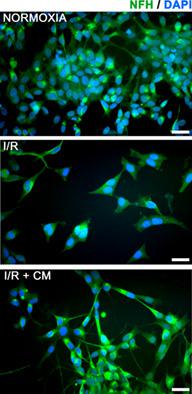当前位置:
X-MOL 学术
›
Stem Cells Transl. Med.
›
论文详情
Our official English website, www.x-mol.net, welcomes your
feedback! (Note: you will need to create a separate account there.)
Neuroprotective effects of human amniotic fluid stem cells‐derived secretome in an ischemia/reperfusion model
STEM CELLS Translational Medicine ( IF 5.4 ) Pub Date : 2020-10-07 , DOI: 10.1002/sctm.20-0268 Vanessa Castelli 1 , Ivana Antonucci 2, 3 , Michele d'Angelo 1 , Alessandra Tessitore 4 , Veronica Zelli 4 , Elisabetta Benedetti 1 , Claudio Ferri 1 , Giovambattista Desideri 1 , Cesar Borlongan 5 , Liborio Stuppia 2, 3 , Annamaria Cimini 1, 6
STEM CELLS Translational Medicine ( IF 5.4 ) Pub Date : 2020-10-07 , DOI: 10.1002/sctm.20-0268 Vanessa Castelli 1 , Ivana Antonucci 2, 3 , Michele d'Angelo 1 , Alessandra Tessitore 4 , Veronica Zelli 4 , Elisabetta Benedetti 1 , Claudio Ferri 1 , Giovambattista Desideri 1 , Cesar Borlongan 5 , Liborio Stuppia 2, 3 , Annamaria Cimini 1, 6
Affiliation

|
Stem cells offer the basis for the promotion of robust new therapeutic approaches for a variety of human disorders. There are still many limitations to be overcome before clinical therapeutic application, including a better understanding of the mechanism by which stem cell therapies may lead to enhanced recovery. In vitro investigations are necessary to dissect the mechanisms involved and to support the potential development in stem cell‐based therapies. In spite of growing interest in human amniotic fluid stem cells, not much is known about the characteristics of their secretome and regarding the potential neuroprotective mechanism in different pathologies, including stroke. To get more insight on amniotic fluid cells therapeutic potential, signal transduction pathways activated by human amniotic fluid stem cells (hAFSCs)‐derived secretome in a stroke in vitro model (ischemia/reperfusion [I/R] model) were investigated by Western blot. Moreover, miRNA expression in the exosomal fraction of the conditioned medium was analyzed. hAFSCs‐derived secretome was able to activate pro‐survival and anti‐apoptotic pathways. MicroRNA analysis in the exosomal component revealed a panel of 16 overexpressed miRNAs involved in the regulation of coherent signaling pathways. In particular, the pathways of relevance in ischemia/reperfusion, such as neurotrophin signaling, and those related to neuroprotection and neuronal cell death, were analyzed. The results obtained strongly point toward the neuroprotective effects of the hAFSCs‐conditioned medium in the in vitro stroke model here analyzed. This can be achieved by the modulation and activation of pro‐survival processes, at least in part, due to the activity of secreted miRNAs.
中文翻译:

人羊水干细胞来源的分泌组在缺血/再灌注模型中的神经保护作用
干细胞为推广针对多种人类疾病的强有力的新治疗方法提供了基础。在临床治疗应用之前仍有许多限制需要克服,包括更好地了解干细胞疗法可能导致加速康复的机制。体外研究对于剖析所涉及的机制并支持基于干细胞的疗法的潜在发展是必要的。尽管人们对人类羊水干细胞的兴趣日益浓厚,但对其分泌组的特征以及在包括中风在内的不同病理中的潜在神经保护机制知之甚少。为了更深入地了解羊水细胞的治疗潜力,通过蛋白质印迹研究了中风体外模型(缺血/再灌注 [I/R] 模型)中人羊水干细胞 (hAFSC) 衍生的分泌组激活的信号转导通路。此外,还分析了条件培养基的外泌体部分中的miRNA表达。hAFSC 衍生的分泌组能够激活促存活和抗凋亡途径。外泌体成分中的 MicroRNA 分析揭示了一组 16 个过度表达的 miRNA,这些 miRNA 参与了连贯信号通路的调节。特别是,分析了与缺血/再灌注相关的途径,例如神经营养蛋白信号传导以及与神经保护和神经元细胞死亡相关的途径。获得的结果强烈表明 hAFSC 条件培养基在本文分析的体外中风模型中具有神经保护作用。这可以通过调节和激活促生存过程来实现,至少部分是由于分泌的 miRNA 的活性。
更新日期:2020-10-07
中文翻译:

人羊水干细胞来源的分泌组在缺血/再灌注模型中的神经保护作用
干细胞为推广针对多种人类疾病的强有力的新治疗方法提供了基础。在临床治疗应用之前仍有许多限制需要克服,包括更好地了解干细胞疗法可能导致加速康复的机制。体外研究对于剖析所涉及的机制并支持基于干细胞的疗法的潜在发展是必要的。尽管人们对人类羊水干细胞的兴趣日益浓厚,但对其分泌组的特征以及在包括中风在内的不同病理中的潜在神经保护机制知之甚少。为了更深入地了解羊水细胞的治疗潜力,通过蛋白质印迹研究了中风体外模型(缺血/再灌注 [I/R] 模型)中人羊水干细胞 (hAFSC) 衍生的分泌组激活的信号转导通路。此外,还分析了条件培养基的外泌体部分中的miRNA表达。hAFSC 衍生的分泌组能够激活促存活和抗凋亡途径。外泌体成分中的 MicroRNA 分析揭示了一组 16 个过度表达的 miRNA,这些 miRNA 参与了连贯信号通路的调节。特别是,分析了与缺血/再灌注相关的途径,例如神经营养蛋白信号传导以及与神经保护和神经元细胞死亡相关的途径。获得的结果强烈表明 hAFSC 条件培养基在本文分析的体外中风模型中具有神经保护作用。这可以通过调节和激活促生存过程来实现,至少部分是由于分泌的 miRNA 的活性。











































 京公网安备 11010802027423号
京公网安备 11010802027423号